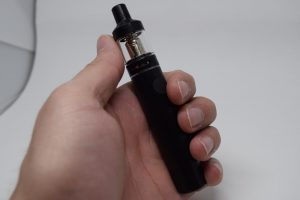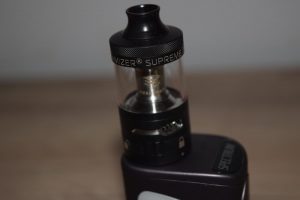Researcher Replicates Two Controversial E-Cigarette Studies, Exposes Serious Methodology Problems
Dr. Konstantinos Farsalinos, a pro-vaping researcher from Greece, has been exposing poor quality e-cigarette studies for over six years now, but he recently took a step further to prove that often times such research is completely inaccurate. Farsalinos spent months replicating two scaremongering studies that had reported huge levels of aldehydes in e-cigarette vapor in order to prove exactly how the authors came up with the outrageous results.
 In 2015, Peyton et al. published a study about “hidden formaldehyde in e-cigarette aerosols“. In it, the authors claimed that in certain conditions, e-cigarettes could be 5 to 15 times more carcinogenic than smoking, emitting incredibly high levels of formaldehyde. As is often the case with studies that put vaping in a bad light, this study received wide media coverage and fueled the efforts of e-cigarette opponents to push strict legislation against them, in the name of public health.
In 2015, Peyton et al. published a study about “hidden formaldehyde in e-cigarette aerosols“. In it, the authors claimed that in certain conditions, e-cigarettes could be 5 to 15 times more carcinogenic than smoking, emitting incredibly high levels of formaldehyde. As is often the case with studies that put vaping in a bad light, this study received wide media coverage and fueled the efforts of e-cigarette opponents to push strict legislation against them, in the name of public health.
Dr. Farsalinos was quick to point out that the study had been conducted in laboratory conditions, using a syringe to emulate human lungs, and that the voltages set on the e-cigarette batteries had generated so-called “dry puffs” that no human vaper would have been able to tolerate. Dry hits occur when the power output is so great that it burns the cotton wick of the atomizer, leaving the e-cigarette user with a mouthful of disgusting smoke. Anyone who’s ever experienced a dry puff knows just how bad they are.
Despite Farsalinos efforts to explain that the conditions in which the high levels of formaldehyde were recorded were simply unrealistic, and pointing out that no formaldehyde had been detected at low voltages, the study generated panic within the vaping community, thanks in no small part to way to the way it was spun by the media.
To prove beyond the shadow of a doubt that the findings of this 2015 study were simply the result of poor methodology, Dr. Konstantinos Farsalinos recently replicated the research using the exact same batteries, atomizers and liquids as the original authors. Only this time, he used actual vapers instead of syringes and machines to report exactly when the dry puff phenomenon occurred.
“Dry puffs were detected at 4.2 V, so 4.0 V was the maximum realistic use voltage. We then tested the device in the laboratory at different voltage settings (both realistic use conditions and dry puffs) and we found, as expected, an exponential increase in formaldehyde emissions at dry puffs,” Farsalinos wrote on his blog, E-cigarette Research. “In fact, at 5.0 V we found much higher levels of formaldehyde than the original research letter. But we did not even dare ask vapers to try that device at 5.0 V. So, we said that e-cigarettes can generate huge levels of formaldehyde, but this happens in conditions that no vaper will ever be exposed.”
Keep in mind, that in the original study, researchers used a top-coil CE4 atomizer with a resistance of 2.1Ω at a whopping 5,5 volts, which generated about 12W. They basically fried it and recorded the results, even though no one could possible vape under those conditions.
The second study replicated by Dr. Farsalinos was originally published in 2016 and found dangerously high levels of aldehydes in e-cigarette vapor. the authors also used a CE4 atomizer at voltages ranging between 3.8V and 4.8V, but – and this is important – with simulated puffs of 5 seconds, which is a lot more than the average time of an actual human puff. They reported extreme emissions of up to 48,000 ug/g formaldehyde, which meant that the exposure to formaldehyde from 5 ml of e-liquid was equivalent to smoking 3200 tobacco cigarettes.
“Today, we published a study replication using the same equipment, power settings and puff duration. Two experienced vapers identified dry puffs at both 3.8 V (obviously due to the very long puff duration) and at 4.8V (in fact, even at shorter puff duration, dry puffs were horrible at 4.8 V),” Dr Farsalinos wrote. “This time, the problem was not only dry puffs; the reported results were also hugely overestimated. We found 6 to 25-fold lower levels of aldehydes at the same dry puff conditions. Furthermore, to assess aldehyde emissions from a realistic use pattern, we tested a relatively new atomizer (Nautilus Mini, which is in fact about 3-years old but has a cotton wick as all new-generation atomizers). The levels of aldehyde emissions were so low that a liquid consumption of 5 mL per day would expose vapers to 94.4-99.8% lower aldehyde levels compared to smoking 20 tobacco cigarettes.”
“Both studies clearly show that it is highly important to evaluate for the generation of dry puffs when measuring e-cigarette emissions in the laboratory,” the Greek researcher added. “Although this has been known for years (from vapers) and has been mentioned in the literature since 2013, still many (if not most) studies fail to examine this.”
Dr. Farsalinos came up with the idea of replicating such controversial studies after noticing that “bad quality studies accompanied by impressive press statements” had become more frequent in recent years. The media coverage only made things a lot worse, and as a result, most smokers today believe that e-cigarettes are just as bad, if not worse, for their health as smoking tobacco. He hopes that by showing the grave errors in methodology and the complete lack of basic vaping concepts like dry puffs or puff duration by the authors will made journal editors and journalists think twice before promoting such studies in the future.
“The field of e-cigarette research has an unusually high number of studies reporting “strange” (to say they least) results. A basic principle that should have been followed is that if the data do not make sense, don’t blame common sense but look at the data for possible mistakes,” Dr Farsalinos said. “It would be interesting to see how the journals and editors who publish these studies will react when the findings of their publications cannot be replicated.”
Farsalinos plans to continue replicating controversial e-cigarette studies, so keep an eye on his blog for more eye-opening revelations.
















